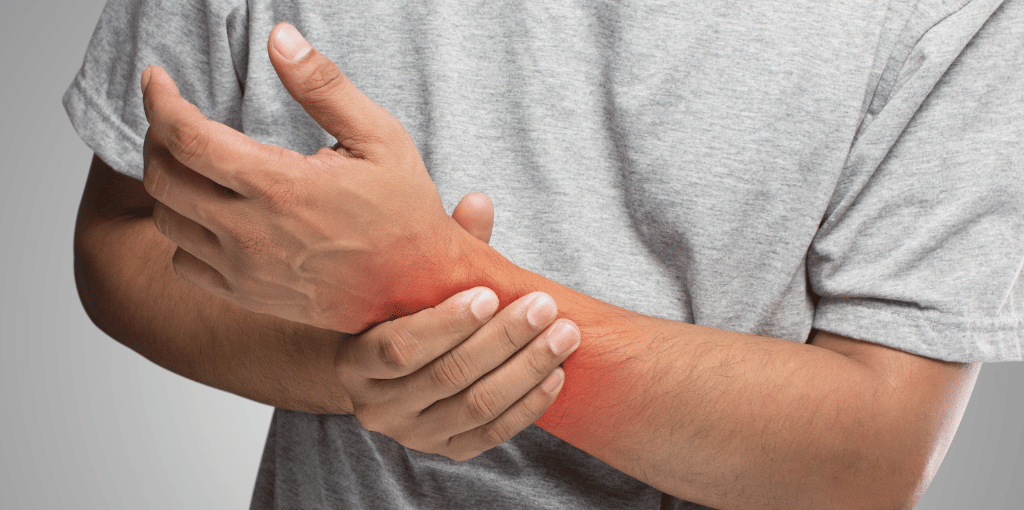Signs of a Sprained Wrist and How to Treat It
- Category: General
- Posted On:

Several ligaments connect the bones in your wrist. You may have a wrist sprain when you injure one or more ligaments. Your sprained wrist might be mild, moderate, or severe. You may have overstretched the ligament or torn it partially. Sometimes, a bad wrist injury can include a minor fracture called an avulsion.
Wrist sprains are common. Your wrist sprain may result from a sports injury, or you might have fallen at home. Treating many wrist sprains at home with rest and care is possible. But sometimes, you’ll need to seek medical care for your injury.
Signs of a Sprained Wrist
Many symptoms can result from a sprained wrist. The most common sign is pain when you try to move your wrist or hand. Other symptoms to look for include:
- Popping or tearing feelings or sounds.
- Swelling or bruising.
- Warmth or tenderness in the area.
- Weakness or difficulty moving the wrist.
Pain, swelling, and bruising can worsen over several days and last for several weeks.

What Causes a Sprained Wrist
Although people who play sports are at increased risk for sprains, anyone can sprain their wrist. Anything that results in twisting or stretching the ligaments of your wrist too far can cause a sprain.
You can injure your wrist if you bend it back too far, twist it suddenly, or sustain a severe impact. Also, overusing the wrist can cause a sprain. In rare cases, infection or certain kinds of arthritis can cause a wrist sprain.
How to Care for a Sprained Wrist
If you have a mild wrist sprain, you may be able to care for it at home. You can use an ice pack to help reduce swelling and keep your wrist slightly elevated. It can also help to wrap your wrist with a compression bandage to apply gentle pressure and combat swelling.
Over-the-counter pain relief can reduce your discomfort while you rest and recover. You may want to avoid using the wrist for several days or longer while it heals.
But, you may need to seek medical care for moderate to severe wrist sprains. And you might have a more severe wrist sprain than you think.
Types of Wrist Sprain
If you seek medical care, the doctor will examine your wrist. You may also need to do some tests like an X-ray, MRI, or CT scan. The doctor will then determine the severity of your wrist sprain. The three grades are:
- Grade 1 or mild sprain. Your ligaments have stretched too far but have not torn.
- Grade 2 or moderate sprain. One or more ligaments have partially torn, and you might need a splint.
- Grade 3 or severe sprain. One or more of your wrist ligaments have torn, and you may also have an avulsion fracture. If your sprained wrist is a grade 3, you could need surgery.

Get Treated for Your Wrist Sprain at Baptist Emergency Room & Urgent Care
A wrist sprain can be a pain and can also stop you from doing daily tasks. It can be hard to tell how severe your injury is on your own. When you need answers, visit Baptist Emergency Room & Urgent Care.
Baptist Emergency Room & Urgent Care's emergency room is open 24/7, and urgent care is available from 7 a.m. to 8 p.m. every day. Appointments are unnecessary - walk in, and our healthcare professionals are ready to help at both of our locations.
Navarre - 8888 Navarre Pkwy., Navarre, FL 32566. Call the center at 850-750-5698.
Nine Mile - 9400 University Parkway Suite 101A Pensacola, FL 32514. Call the center at 448-227-4600.
Baptist Emergency Room & Urgent Care is comprised of board-certified ER-trained physicians and professionally trained ER nurses who deliver quality medical care. Our urgent care and emergency room can effectively treat various medical conditions. From fever to fractures, allergies to abdominal pain, and colds to concussions, we have you covered with on-site labs, CT, X-rays, and ultrasound.
[1].png)